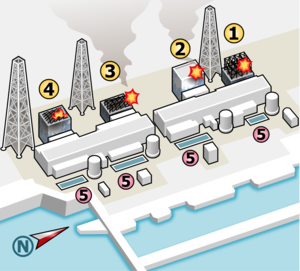
 |
| Fig. 1: Diagram of the Nuclear Power Plant Disaster in Okuma. (Source: Wikimedia Commons) |
In March of 2011, an energy accident occurred at the Fukushima Daiichi Nuclear Power Plant in Okuma Fukushima Prefecture. The Fukushima Daiichi nuclear disaster (see Fig. 1) was initiated by the 15-meter tsunami that occurred following the Tohoku earthquake. This tsunami disabled the power supply and cooling of three reactors in the plan, causing them to shut down their sustained fission reactors. The tsunami disabled the generators that would have provided power to cool the reactors. Because of this, three nuclear meltdowns, hydrogen air explosions, and the release of radioactive material occurred during this time. This nuclear accident was rated 7 on the INES scale. There were no deaths or causes of radiation sickness from this accident, but over 100,000 people were evacuated from their homes to escape the leak. There were, however, over 1,000 deaths that occurred while maintaining the evacuation. [1]
In the early phase of this accident, many radionuclides were released into the air and were transported onto the sea surface of the Pacific Ocean. These radionuclides were transported eastward via a strong jet stream and in a mere four days, reached the coast of North America. In addition, it was reported in April, 2011 that highly contaminated water that was used for stabilizing the power plants was deposited directly into the ocean. These two sources were responsible for the contamination of the Pacific Ocean. Concentration factors, which mainly consists of the degree of radionuclide enrichment in biota that is relative to ambient water, are used to evaluate the radiological risks that are associated with seafood consumption. It was found that the median concentration of Cs-137 in micronektonic fish (secondary consumers) was less than that in zooplankton (primary and secondary consumers) and was about 150-fold below the legal limit in Japan. The surface ocean Cs led to several conclusions regarding Fukushimas impact on the ocean. The first conclusion is that Fukushima-derived Cs-134 and Cs-137 were measured at up to 1,000x higher activities than what existed before. Additionally, they were found throughout a 150,000 km squared area of the Pacific Ocean near Japan. The second conclusion is that a large amount of dilution had occurred between the discharge channels at the Fukushima nuclear power plants. [2] Regarding biological impacts, radiation doses in marine life are dominated by radionuclides that are naturally occurring, such as Po-210. In order to be comparable to these doses of naturally-occurring radionuclides, the levels in these fish would need to be three times of higher magnitude than what was observed off the coasts of Japan. Therefore, the radiation risks of these isotopes to marine organisms are below those of natural radionuclides. [2]
Since the incident, many efforts have been put in to alleviate the situation and to decontaminate the affected areas. There were three approaches to decontamination. The first was physical decontamination, which involved including removing superficial or airborne radionuclides by applying mechanical force directly, or using water or air. The second approach was chemical decontamination, which used atomic-level interactions to concentrate radionuclides into smaller masses of material. The last approach that was used was biological decontamination, which employed living systems preferences for absorbing the atoms of particular elements. This would concentrate radionuclides to form a medium into a mass that was much smaller, and made of organic material. [3] Today, the plants compound has mainly green zones where workers are allowed to walk around with light work clothes and a disposable mask. This is considered to be a major achievement considering how high the radiation levels were at the time of the accident. However, Japan is still struggling to figure out how to dispose of the increasing volumes of radioactive water that is now being stored in temporary water tanks on the compound. [4]
© Caroline Lampl. The author warrants that the work is the author's own and that Stanford University provided no input other than typesetting and referencing guidelines. The author grants permission to copy, distribute and display this work in unaltered form, with attribution to the author, for noncommercial purposes only. All other rights, including commercial rights, are reserved to the author.
[1] K.-S. Suh et al., "Atmospheric Dispersion and Sea Surface Deposition of Radionuclides by the Fukushima Nuclear Accident," J. Coastal Res. 79, 85 (2017).
[2] K. O. Buesseler, "Fukushima-Derived Radionuclides in the Ocean and Biota off Japan," Proc. Natl. Acad. Sci. (USA) 109, 5984 (2012).
[3] C. Dion-Schwarz et al., Technological Lessons from the Fukushima Dai-Ichi Accident (RAND Corporation, 2016), p. 2936.
[4] S. Murai, "Fukushima No. 1 Cleanup Continues but Radioactive Water, and Rumors, Also Prove Toxic," Japan Times, 9 Mar 18.